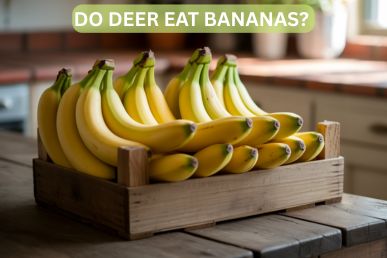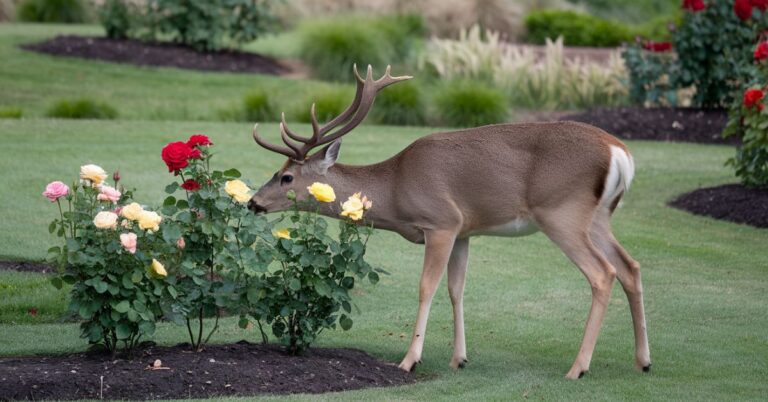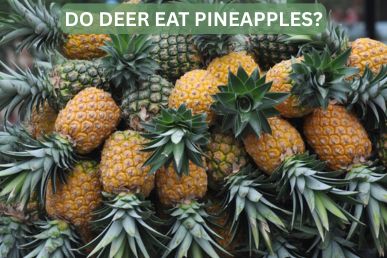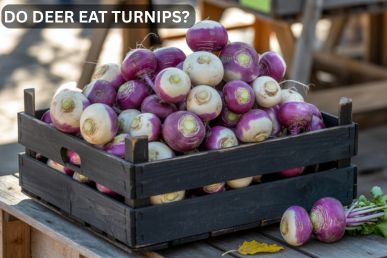Do Deer Eat Tomatoes? 11 Best Tips to Protect Your Plants
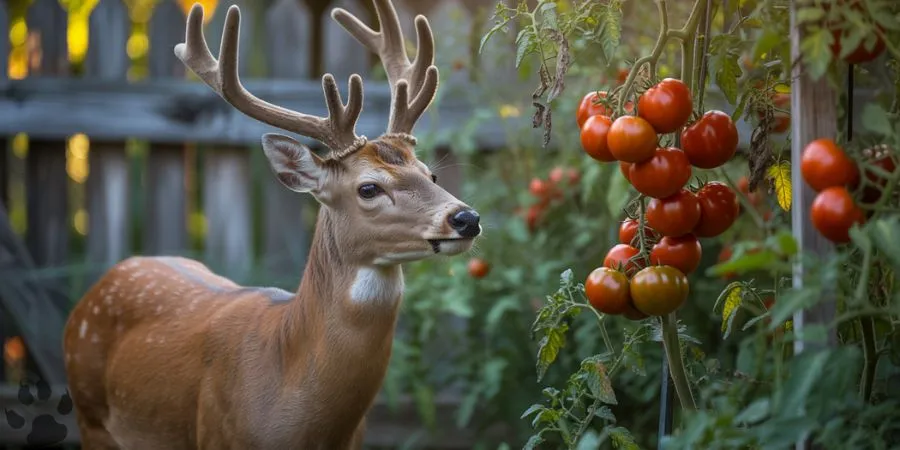
Ever wonder why your beautiful tomato plants sometimes look like they’ve had a midnight snack? If so, you might be right to blame the deer. Yes, deer absolutely eat tomatoes and tomato plants! They find both the fruits and the leaves and stems quite tasty.
It often leads gardeners to ask, Do deer eat tomatoes, or Is something else to blame? When their usual forest food becomes scarce, especially in summer and fall, deer often wander into yards looking for an easy bite.
An unprotected garden is like a dinner bell for them. In this article, we’ll explore why deer are so attracted to tomato gardens, how to spot the signs of their damage, and most importantly, share ways to keep them away using proven methods.
If you’re a backyard gardener feeling frustrated or just curious about how to protect your tomatoes from becoming a deer’s next meal, you’re in the right place!
How to Tell if Deer Are Eating Your Tomatoes
Deer are among the few animals that can attack your garden, and there are some signs that you can look for to tell if a deer has attacked your garden.
1st Sign: Torn leaves
- Check your tomato plant carefully. See the leaves? If they look torn with rough, jagged edges, that’s a big clue!
- This messy look is a classic telltale sign of deer.
- Unlike bugs that chew neatly, deer use their sharp front teeth (incisors) to grab and pull. This pulling action rips the leaves and stems as they eat.
2nd Sign: The tops of the plants are eaten
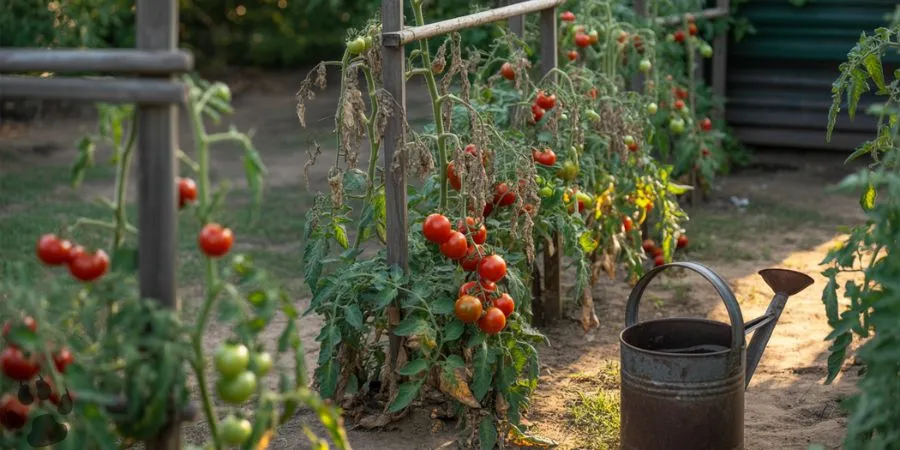
You’ll notice the tops of your plants are eaten, especially the tender, new growth. Deer usually eat this first because it’s easy to reach at their grazing level (around 3-4 feet in height). The rest of the plant often stays untouched.
3rd Sign: Widespread damage
Unlike rabbits or other small animals, deer cause widespread damage. They travel in groups and graze together, nibbling as they move from plant to plant. This often results in multiple tomato plants being stripped at once.
4th Sign: New damage
Check for fresh damage first thing in the early morning. Deer love to eat tomatoes and often graze at dusk or dawn – that’s their favorite munching time! These animals prefer to feed when it’s quiet. So, check your plants then and look for tooth marks.
5th Sign: Large bites
- Smaller animals like rabbits leave tiny bites on your tomatoes.
- But deer eat differently! They take bigger pieces once they find your plants.
6th Sign: Deer tracks
Looking for clues? Deer leave clear tracks in soft soil—check for footprints! They often graze together, so you’ll spot larger quantities of prints in trampled areas of your garden.
Are Tomato Plants Toxic to Deer?
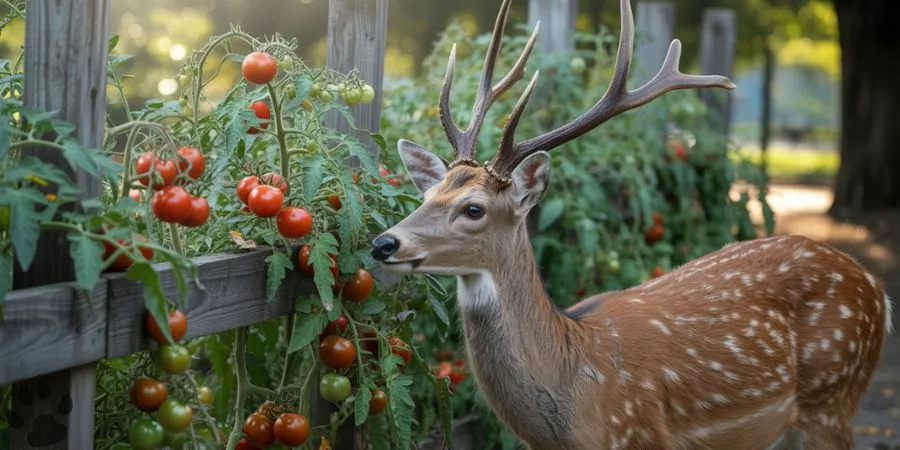
While tomato plants are not highly toxic to deer, they do contain natural chemicals called alkaloids (solanine and tomatine) mainly in their green leaves and stems.
These can be harmful in very large quantities, but the levels found in the plants are usually too low to pose a serious health risk to a browsing deer. Even the ripe tomatoes themselves have very low amounts.
So, deer often munch on the plants and fruit, filling their bellies and potentially ruining a gardener’s bountiful harvest.
11 Tips to Keep Deer From Eating Your Tomatoes
You can apply whichever of the following tips you find best to your garden to save your tomato plants.
Tip No. 1: Fencing
Let’s discuss installing a fencing barrier around your prized tomato plants. This is a super common item gardeners use to stop hungry visitors. Think of it like building a strong wall around your yummy garden snacks!
The main troublemakers are deer and rabbits, right? They love tomatoes! But sometimes, other neighborhood critters like raccoons or even loose dogs might try their luck too. A good fence keeps them all out.
Watch the following video of an expert on deer fencing installation.
Permanent Fencing
When you dream about protecting your garden from deer, permanent fencing is probably the type that pops into your head first. It seems nice because you install it just once, and it can last for many years.
I remember building one a few summers ago—it felt like a one-time solution. But hold on, there are some drawbacks to consider. Getting the right materials can get really expensive. For example, the wooden posts I chose nearly doubled my budget.
Putting it all up is also super labor-intensive, meaning it takes a lot of hard work. It took me three full weekends to get everything in place.
Plus, once it’s built, you might not have any room left to expand your garden later if you want to grow more tomatoes! Last year, I built a permanent fence, but now I can’t grow pumpkins where I want.
For a ready-made option, this deer-proof garden fence kit is easy to set up and perfect for seasonal tomato protection.
Temporary Fencing
Got deer munching your favorite tomatoes? A common issue for years is that a basic 4-foot fence won’t stop them – deer can easily jump over it! That’s where temporary fencing comes in.
Think of using lightweight poultry netting; you can easily set it down around your garden bed this spring and run it where needed.
Need to protect a large area? You can expand the netting. If those critters are persistent, adding an electric wire powered by a solar unit adds a safe zap they’ll remember.
The best part? When the season ends, you can change the shape or just pack it neatly away until next year, keeping your tomato dream safe with this effective solution.
Tip No. 2: Predator Eyes
Deer are natural prey for predators like coyotes, cougars, bobcats, wolves, and bears. Use fake glowing eyes around your garden! They trick deer into thinking danger is near, scaring them away. This fun trick helps capitalize on their fear to keep tomatoes safe.
Tip No. 3: Motion-Activated Sprinkler
Place a motion-activated sprinkler in your garden. Its detector spots oncoming traffic like deer or critters. The sprinkler head then sprays water to scare them away! Adjust it to cover a 1600-square-foot area. Simply pick a spot to protect your prized tomatoes.
I’ve heard great results using a motion-sensing sprinkler like this one—it deters deer without harming them.
Watch the following short demo on how motion sprinklers work.
Tip No. 4: Companion Planting
Deer tend to avoid strong-smelling herbs and flowers, so using these can protect your garden! According to Oregon State University, daffodils, lavender, russian sage, rhubarb, and yarrow are just deer-resistant, not deer-proof.
The university also calls catmint a top choice since it’s naturally resistant. By planting these types of helpers near your tomatoes, you’ll reduce the likelihood of deer damage.
Tip No. 5: Deer-Repellent Sprays
Want a chemical-free trick to protect your tomatoes? Try making homemade deer repellent spray! I mix mint oil and garlic with water—it’s oil-based and super fragrant, which deer hate.
The big advantage? It’s potent but gentle on your plant. Just remember that heavy rain can gradually wash away the solution, so you’ll need to reapply it.
Speaking from my garden adventures, utilize this spray every few weeks. Its natural features mean it won’t hurt your veggies or the earth!
Don’t want to mix your own? Try this ready-to-use natural deer repellent spray with weather-resistant staying power.
Tip No. 6: Ultrasonic Deer Repellents
These clever devices utilize high-pitched ultrasonic sounds that only animals like deer can hear. When a hungry critter (or any pest) enters the vicinity, the repellers send out sound in their direction.
Deer really kick at this noise! They usually can’t stand it, turn around, and head back the way they came. Thankfully, humans don’t hear a thing. Just point the direction correctly and let it run all the time for the best results.
Try an ultrasonic deer repeller like this one; it’s solar-powered, easy to place, and runs 24/7.
Tip No. 7: Build a micro-enclosure
Here’s a helpful deer-deterrent hack I’ve picked up over time: deer don’t like moving into tight or cramped spaces because it limits their ability to flee quickly if startled.
You can use this natural instinct to your advantage in the tomato garden. Rather than fencing a huge area, try enclosing just your tomato patch with a low 4-foot fence around a compact square, roughly 16 by 16 feet.
This smaller zone feels risky to deer, so they tend to steer clear. It’s a smart way to protect your veggies without building an entire perimeter fence!
Tip No. 8: Hang a bar of soap nearby.
Protecting your precious tomato plant is key, whether it’s in a big garden, a small container, or a raised bed. One simple trick involves using a common bar of fragrant bath soap.
Deer dislike strong smells, so when they start browsing near your tomatoes, especially right when they begin to ripen, fragrant soap can send them packing!
Here’s how: Take a highly scented bar and drill a small hole right through it. Thread some sturdy yarn or jute twine through the hole. Then, simply hang the soap bar from a stake placed near your tomato plant.
For several plants, place individually wrapped bars around the perimeter of your planting area to create a smelly fence they won’t want to cross.
Tip No. 9: Spray the soil with a raw egg mixture.
Here’s a cool trick from wildlife specialists: whip up a raw egg slurry to effectively repel deer! Just mix a dozen raw eggs with 5 gallons of water until they’re blended.
Pour the mixture into a sprayer, then apply it to the soil around your tomato plants. What happens next? The eggs slowly rot in the ground, producing a putrid odor that deer hate—but it’s usually too faint for humans to detect.
If rain washes it away, you’ll need to reapply the mixture to keep those deer from sneaking back!
Tip No. 10: Sprinkle the soil with bone meal and blood meal
Try sprinkling a dry mix of bone meal and blood meal around your precious tomato plants. This product works because its smell is proven helpful for repelling hungry deer.
Simply mix equal parts of both meals and lightly sprinkle this dry powder onto the soil near the tomato plants. These natural enhancements are great deer deterrents!
Just remember, rain can wash the smell away, so you’ll need to reapply the mixture after heavy downpours to keep it working.
Tip No. 11: Plant Food for the Deer
Instead of fighting hungry deer, give them their own tasty snacks far from your precious tomatoes!
Try planting yummy food like crunchy lettuce, sweet strawberries, carrots, juicy fruits like watermelon, and easy-to-grow vegetables —such as potatoes or members of the brassica crew like cabbage, kale, and broccoli—in a special corner of your yard.
Growing these deer favorites in empty areas or along the edges of your property deters them from targeting your main garden. When deer find these delicious plants waiting, they’ll munch there instead of bothering your tomato plants!
What Other Plants Do Deer Eat?
Since deer are natural herbivores, they graze on a huge variety of plants every single day.
You’ll spot them munching on tender grasses, tasty berry bushes, crunchy acorns, and even fruits like oranges, especially when they’re ripe and easy to access. They also enjoy young trees like aspen, maple, and poplar, and wild plants such as honeysuckle, sumac, and goldenrod.
They absolutely love crops like corn and fruits such as apples, too! A hungry deer needs to eat about 12 lbs of food daily, so they constantly searches for vegetation to fill their bellies.
Final Thoughts: Do Deer Eat Tomatoes?
So yes, deer absolutely love tomato plants, especially when they’re hungry! You might find them munching away on your precious fruits. But don’t panic! There are smart preventive measures you can take.
Implementing strong fencing around your garden is the best start. Installing motion-activated sprinklers also works wonders – they surprise deer with a splash! Incorporating certain smelly companion plants nearby can help, too.
By incorporating these steps, you significantly reduce the chances of your tomatoes becoming a deer snack. While a plant might occasionally still fall victim, these actions mean you need not give up hope on growing tasty tomatoes!
FAQ’s
Do Deer Eat Green Tomatoes?
Whether tomatoes are ripe or still green, deer can eat them either way. Deer will never leave tomatoes, whether they are green or red.
Do deer eat tomatoes with leaves and branches?
Deer have often been seen eating tomato leaves and branches, often targeting tomato plants when they are in the new growth stages.



